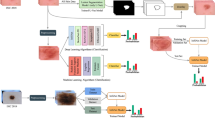Abstract
Skin cancer is growth of abnormal cells, mainly caused due to exposure of ultraviolet rays from sun. There are various types of skin cancer, among them melanoma is the most hazardous. Manual detection of skin cancer is a time-consuming task. In order to reduce the time constraint, various computer aided diagnosis are introduced. Among them deep learning is more advantageous because it can be performed on large amount of data. Deep learning is a subset of machine learning, which extracts features from raw input. This paper deals with various deep learning architectures proposed by several researchers for detection and segmentation of skin cancer. The commonly used architectures for detection of skin cancer are convolutional neural network (CNN), k-nearest neighbor (k-NN), artificial neural network (ANN), deep convolutional neural network (DCNN) and you only look once (YOLO). For skin cancer segmentation DermoNet, U-net, GrabCut, saliency based and fully convolutional network (FCN) are used. For the abovementioned architectures, the authors have used different datasets such as ISIC 2017, ISIC 2018, ISBI 2016, ISBI 2017 and PH2 for detection and segmentation of skin cancer. To access the correctness of segmentation and classification various performance measures such as: accuracy, sensitivity, specificity, Jaccard coefficient, Dice similarity coefficient, Hammoude distance, XOR and area under curve are computed for different architecture. A detailed comparison of various methods based on their performances is discussed in this paper. Among them the method using CNN has attained highest accuracy of 97.49%.
Access this chapter
Tax calculation will be finalised at checkout
Purchases are for personal use only
Similar content being viewed by others
References
Ahn E, Kim J, Bi L, Kumar A, Li C, Fulham M, Feng DD (2017) Saliency-based lesion segmentation via background detection in dermoscopic images. IEEE J Biomed Health Inf 21:1685–1693. https://doi.org/10.1109/JBHI.2017.2653179
Albahar MA (2019) Skin lesion classification using convolutional neural network with novel regularizer. IEEE Access 7:38306–38313. https://doi.org/10.1109/ACCESS.2019.2906241
Alfed N, Khelifi F, Bouridane A, Seker H (2015) Pigment network-based skin cancer detection. In: 37th Annual international conference of the IEEE engineering in medicine and biology society (EMBC), Milan, pp 7214–7217. https://doi.org/10.1109/EMBC.2015.7320056
Baghersalimi S, Bozorgtabar B, Schmid-Saugeon P, Ekenel HK, Thiran JP (2019) Dermonet: densely linked convolutional neural network for efficient skin lesion segmentation. EURASIP J Image Video Process 7. https://doi.org/10.1186/s13640-019-0467-y
Begum S, Asra S (2017) Extraction of skin lesions from non dermoscopic images using deep learning. Int J Sci Res Comput Sci 2:591–596
Bi L, Kim J, Ahn E, Feng D, Fulham M (2016) Automatic melanoma dtection via multi-scale lesion-biased representation and joint reverse classification, pp 1055–1058. https://doi.org/10.1109/ISBI.2016.7493447
Farooq MA, Azhar MAM, Raza RH (2016) Automatic lesion detection system (alds) for skin cancer classification using svm and neural classifiers. In: IEEE 16th international conference on bioinformatics and bioengineering (BIBE), Taichung, pp 301–308. https://doi.org/10.1109/BIBE.2016.53
Hasan SN, Gezer M, Azeez RA, Gulsecen S (2019) Skin lesion segmentation by using deep learning techniques, pp 1–4. https://doi.org/10.1109/TIPTEKNO.2019.8895078
Hosny KM, Kassem MA, Foaud MM (2018) In: 9th Cairo international biomedical engineering conference (cibec), pp 90–93. https://doi.org/10.1109/CIBEC.2018.8641762
Khamparia A, Singh A, Anand D, Gupta D, Khanna A, Kumar NA, Tan J (2018) A novel deep learning-based multi-model ensemble method for the prediction of neuromuscular disorders. In: Neural computing and applications. https://doi.org/10.1007/s00521-018-3896-0
Huang LK, Wang MJJ (1995) Image thresholding by minimizing the measures of fuzziness. Pattern Recogn 28:41–51. https://doi.org/10.1016/0031-3203(94)E0043-K January
Jafari MH, Karimi N, Esfahani E, Samavi S, Soroushmehr SMR, Ward K, Najarian K (2016) Skin lesion segmentation in clinical images using deep learning. In: 23rd International conference on pattern recognition (ICPR), Cancun, pp 337–342. https://doi.org/10.1109/ICPR.2016.7899656
Mishra R, Daescu O (2017) Deep learning for skin lesion segmentation. In: IEEE international conference on bioinformatics and biomedicine (BIBM), Kansas City, pp 1189–1194. https://doi.org/10.1109/BIBM.2017.8217826
Raj RJS, Shobana SJ, Pustokhina IV, Pustokhin DA, Gupta D, Shankar K (2020) Optimal feature selection-based medical image classification using deep learning model in internet of medical things. IEEE Access 8:58006–58017. https://doi.org/10.1109/ACCESS.2020.2981337
Unver HM, Ayan E (2019) Skin lesion segmentation in dermoscopic images with combination of yolo and grabcut algorithm. Diagnostics 9(72):97–114. https://doi.org/10.3390/diagnostics9030072 July
Yuan Y, Chao M, Lo YC (2017) Automatic skin lesion segmention using deep fully convolutional networks with jaccard distance. IEEE Trans Med Imaging 36:1876–1886. https://doi.org/10.1109/TMI.2017.2695227
Author information
Authors and Affiliations
Corresponding author
Editor information
Editors and Affiliations
Rights and permissions
Copyright information
© 2021 The Author(s), under exclusive license to Springer Nature Singapore Pte Ltd.
About this paper
Cite this paper
Duggani, K., Nath, M.K. (2021). A Technical Review Report on Deep Learning Approach for Skin Cancer Detection and Segmentation. In: Khanna, A., Gupta, D., Pólkowski, Z., Bhattacharyya, S., Castillo, O. (eds) Data Analytics and Management. Lecture Notes on Data Engineering and Communications Technologies, vol 54. Springer, Singapore. https://doi.org/10.1007/978-981-15-8335-3_9
Download citation
DOI: https://doi.org/10.1007/978-981-15-8335-3_9
Published:
Publisher Name: Springer, Singapore
Print ISBN: 978-981-15-8334-6
Online ISBN: 978-981-15-8335-3
eBook Packages: Intelligent Technologies and RoboticsIntelligent Technologies and Robotics (R0)




